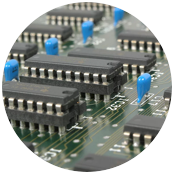Film capacitors, as a category, include any capacitor type made from plastic: polyester, polypropylene, polystyrene, and so on. There are at least two types of film capacitors: Film-foil capacitors are constructed of layers of plastic film dielectric wound alternately with metal foil electrodes. Metallized film capacitors are constructed of film dielectrics on which the metal electrodes have been previously vapor-deposited. The layers are wound into a convoluted roll, with electrodes extending beyond the dielectric films.
Film capacitors are designed using a number of different dielectrics (the insulating material between the plates of the capacitor). Dielectric materials are chosen for their ability to permit electrostatic attraction and repulsion to take place across the film. The dielectric materials ensure that any energy required to establish an electric field is recoverable, in whole or in part, as electric energy. In other words, good dielectric material is a poor conductor of electricity while being an effective supporter of electrostatic fields. Common dielectrics used in film capacitors include polyester, polycarbonate, polypropylene, and polystyrene.
Polyester film capacitors offer a high dielectric constant and high dielectric strength with volumetric efficiency. Metallized polyester film has excellent self-healing properties, and typical applications for such capacitors include bypassing and coupling.
Polypropylene provides very low losses, low dielectric absorption, and high dielectric strength. In addition, polypropylene film capacitors offer very high insulation resistance and a negative temperature coefficient. Typical applications include stable oscillators and filters, sample and hold circuits, and pulse-handle circuits. Tecate's film capacitors are primarily used for circuit bypass, blocking, and filtering.


